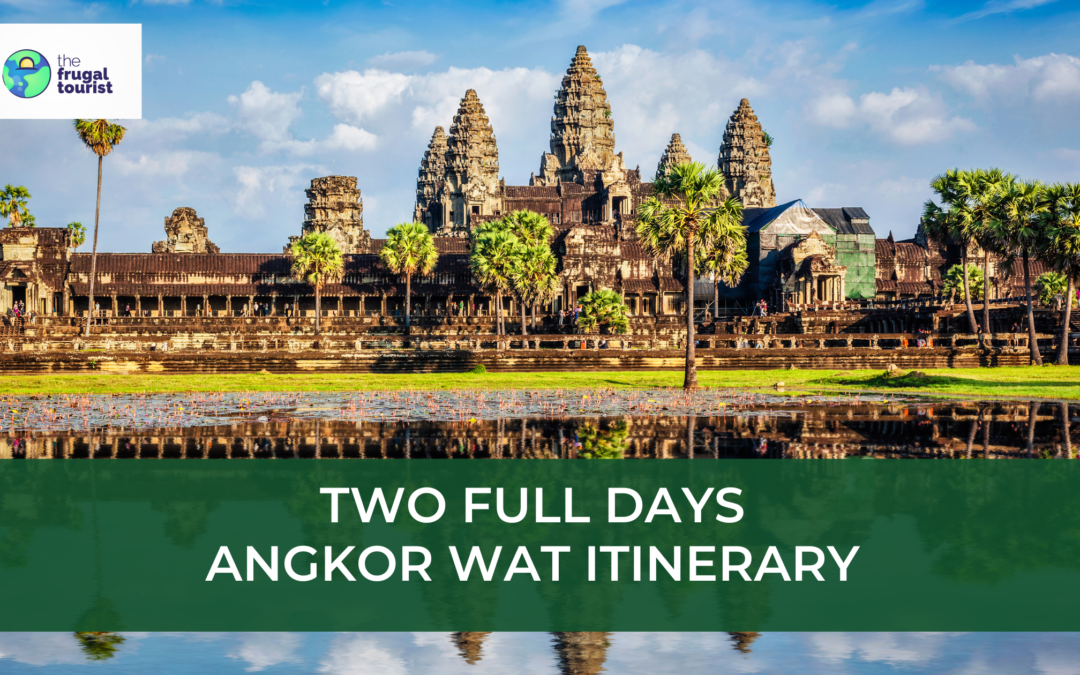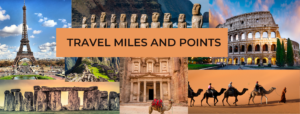ADVERTISER DISCLOSURE: The Frugal Tourist is part of an affiliate sales network and receives compensation for sending traffic to partner sites, such as MileValue.com. This compensation may impact how and where links appear on this site. This site does not include all financial companies or all available financial offers. Terms apply to American Express benefits and offers. Enrollment may be required for select American Express benefits and offers. Visit americanexpress.com to learn more. Additionally, the content on this page is accurate as of the posting date; however, some of the offers mentioned may have expired.
Angkor Wat is one of the most impressive archaeological sites in Southeast Asia.
Located in Cambodia, it was once the great capital of the Khmer Empire and remains a powerful symbol of Cambodian culture today.
Spanning over 400 acres, Angkor Wat contains numerous temples, monuments, and other structures that testify to its former grandeur.
A visit to this incredible site will be an unforgettable experience for any traveler looking to explore ancient history and culture.
In this blog post, I will list all the highlights of this vast temple complex.
With two full days at your disposal, you can take advantage of all there is to see and do at Angkor Wat.
My first visit to these temples was back in 2007, so I was glad to revisit them after 16 years in 2023. I was astonished to see the ruins in terrific condition.
Angkor Wat continues to be one of my favorite archaeological sites in the world and is a must-see destination for any traveler.
Why Visit the Temples of Angkor Wat
This ancient temple complex in Siem Reap, Cambodia, is a UNESCO World Heritage Site and one of the world’s most remarkable architectural and historical treasures.
Here are reasons why I think Angkor Wat should be at the top of every traveler’s bucket list:
Architectural Marvel
Angkor Wat is a testament to the ingenuity and skill of the Khmer Empire.
The architecture is simply mind-blowing, with intricate details, towering spires, and perfectly balanced structures.
When you visit the temple complex, you’ll be left in awe of the craftsmanship and engineering skills of the ancient Khmer civilization.
It’s like stepping into a world of wonders! They were way ahead of their time.
Historical Significance
Angkor Wat started as a Hindu temple dedicated to the god Vishnu, but then it went through a transformation and became a Buddhist temple.
Pretty cool, right? This site played a crucial role in the Khmer Empire, one of the most influential and prosperous civilizations in Southeast Asia.
Exploring Angkor Wat allows visitors to immerse themselves in the region’s rich history and cultural heritage.
Symbolic and Spiritual Importance
Angkor Wat is truly remarkable. It holds immense religious significance and its layout reflects Hindu cosmology.
Each section symbolizes a different world in Hindu mythology. Explore and connect with ancient tales and profound beliefs.
The temple’s towering central spires symbolize Mount Meru, the mythical home of the gods. It was difficult not to feel a sense of spirituality when visiting Angkor Wat.
Breathtaking Sunrise and Sunset Views
Angkor Wat is renowned for its stunning sunrise and sunset views.
Witnessing the sun rising over the temple’s silhouette or setting behind the ancient structures creates a magical experience.
The warm hues of the sky casting a golden glow over the temple complex make for unforgettable moments and incredible photo opportunities.
Cultural Immersion
Angkor Wat provides an immersive cultural experience that allows travelers to connect with Cambodia’s vibrant history and heritage.
Interacting with the locals and witnessing daily rituals by monks adds an authentic touch to your visit.
The warmth and hospitality of the locals enrich your experience, making it more than just sightseeing.
Don’t miss this opportunity to immerse yourself in the local culture and create unforgettable memories!
Pro-Tip: Whenever I visit Angkor Wat, I make sure that I visit the Siem Reap public market so I can observe and interact with the locals.
Surrounding Temple Complex
Angkor Wat is just one part of the larger Angkor Archaeological Park, which spans over 400 square kilometers.
The park has numerous temples, each with unique features and charm.
Exploring the other temples, such as Ta Prohm with its famous tree roots or Bayon with its mysterious stone faces, adds depth and variety to your temple visit.
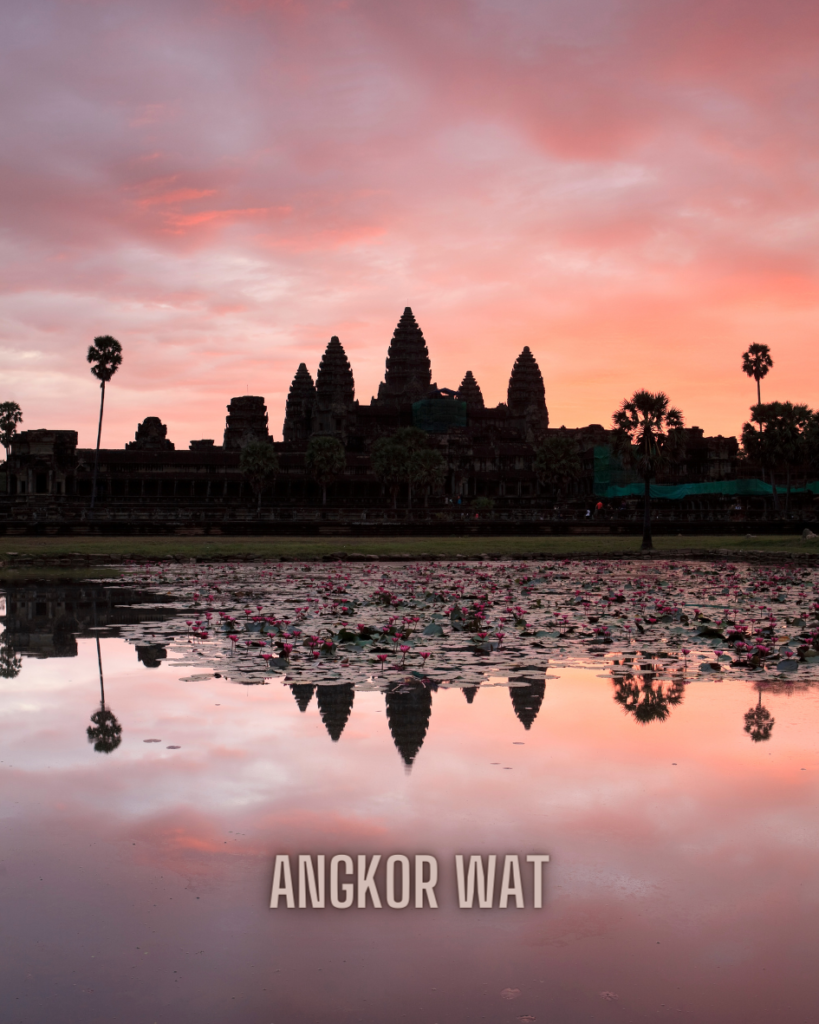
Getting There & Airport Transfers
The town of Siem Reap is the gateway to the temples of Angkor Wat. The airport code for Siem Reap is REP.
Starting Nov 2023, Siem Reap has a new airport. The new airport code is SAI.
SAI is served by several Southeast Asian carriers such as Vietnam Airlines, Singapore Airlines, Bangkok Airways, etc.
For airport transportation information, check out this blog post for the most current news.
Pre-Arranging Your Tour
There are a lot of tour agencies in town with practically identical itineraries.
Take a look at this blog post to review your preferred itinerary before finalizing your decision on a particular driver or company.
Communicating clearly with your driver is essential to avoid missing any important highlights during the trip.
Additionally, make sure that you have explicitly agreed on the price of the tour.
Just be mindful that drivers charge extra fees for the drive to Banteay Srei since it is located outside the Angkor Wat Complex.
Lastly, renting a tuk-tuk and airconditioned sedans is charged per car, not per person, so the bigger the group, the cheaper the daily rent rate.
Must-Do: Ride the Tuk-Tuk at least once while exploring the temples.
We liked our Grab driver and hired him for our temple tours and transport back to REP. His name is Mr. Rattol, and his WhatsApp contact information is 087 312 269.
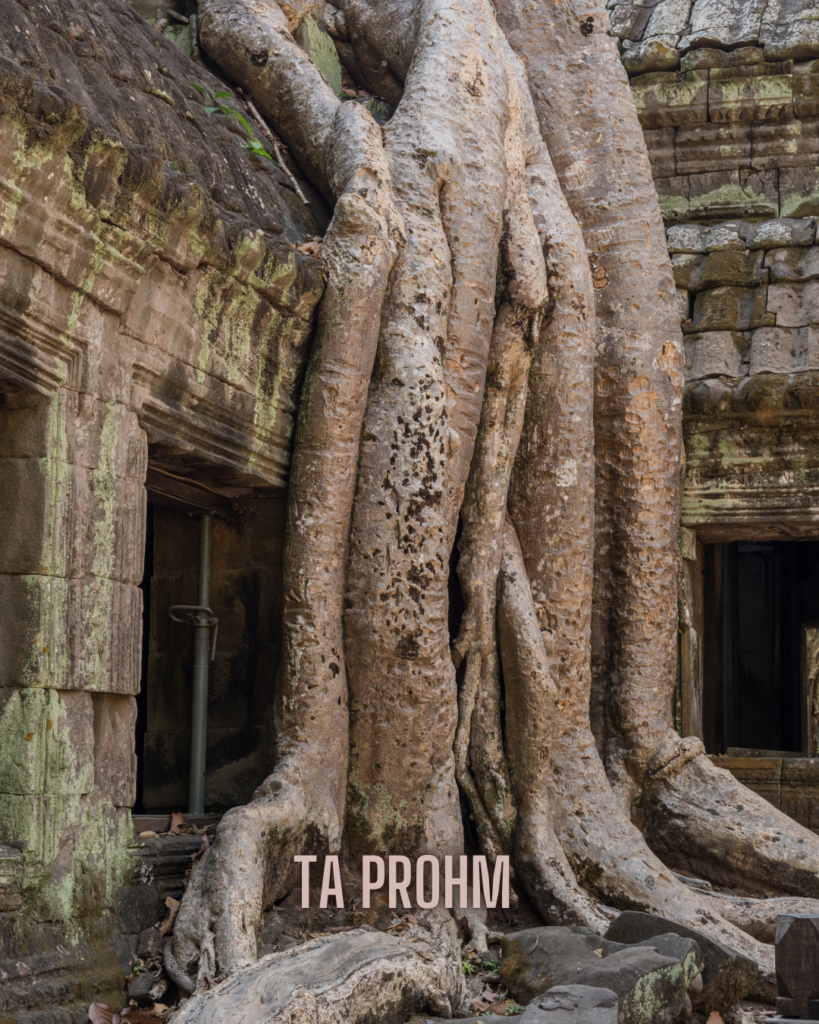
Tickets
It is recommended to purchase tickets online.
Take a screenshot of the QR code, which will be checked and scanned at specific areas within the temple complex.
| Number of Days | Ticket Price (2023) |
|---|---|
| 1 Day | $37 |
| 3 Days | $62 |
| 7 Days | $72 |
Recommended Itinerary
| Day | Activity |
|---|---|
| Day 1 | Arrive in REP Check-in at hotel Walk to downtown (Pub Street) Shop around for best tour |
| Day 2 | Sunrise at Angkor Wat Ta Prohm Bayon Angkor Thom Sunset at Phnom Bakheng |
| Day 3 | Banteay Srei Preah Khan Neak Phan Ta Som East Mebon Pre Roup Sra Srang Banteay Kdei Prasat Kravan |
| Day 4 | Depart for your next destination or take tours to any of these destinations: Phnom Kulen National Park Ton Le Sap Lake |
Downloadable Map
Feel free to save and share this downloadable map.
Day 1 = Red pins
Day 2 = Blue pins
Banteay Srei = Green Pin
Day One: Angkor Wat, Ta Prohm, and Bayon
Sunrise at Angkor Wat
5:00 AM – Start your day early by heading to Angkor Wat temple to witness a breathtaking sunrise. This is one of the most iconic experiences in Siem Reap and shouldn’t be missed.
The temple complex opens at 5:00 am, so arrive earlier to secure a good spot. Witnessing the sun rising over the iconic temple is a truly awe-inspiring experience.
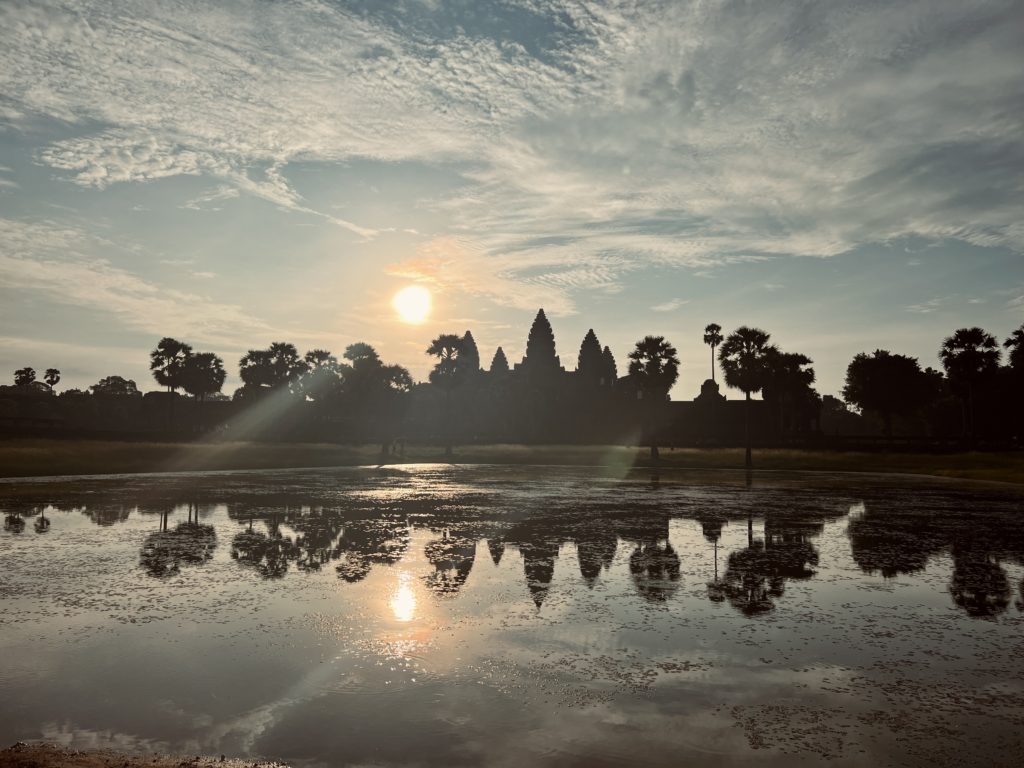
Exploring Angkor Wat
7:00 AM – After experiencing the sunrise, it is time to explore the Angkor Wat temple.
Spend a few hours exploring the main attractions of Angkor Wat, including the central towers, galleries, and intricate carvings.
As you explore the temple complex, watch for intricate details, symmetrical layouts, and the overall harmonious design showcasing the Khmer Empire’s architectural genius.
What to look out for at Angkor Wat:
Central Towers
The central towers of Angkor Wat are the temple complex’s most iconic and recognizable elements.
These towering spires, or prasats, rise above the surrounding structures and create a dramatic skyline.
Take a moment to admire these towers’ intricate design and symbolic significance.
Bas-Reliefs
Angkor Wat is adorned with extensive bas-reliefs that cover its walls and galleries.
These stone carvings depict various scenes from Hindu mythology, historical events, and everyday life during the Khmer Empire.
Spend time exploring the galleries and tracing the detailed carvings that tell stories from the ancient past.
Apsaras
Apsaras, or celestial nymphs, are a recurring motif in Angkor Wat’s architecture.
These exquisite female figures are elegantly carved into the walls and pillars of the temple.
Look for their graceful poses, intricate hairstyles, and delicate facial expressions.
The apsaras add elegance and beauty to the temple’s overall design.
Libraries
Angkor Wat features four small libraries, two on each side of the central temple complex.
These libraries are characterized by their decorative towers and exquisite carvings.
While they might be smaller in scale compared to the main temple, they showcase the attention to detail and the harmonious design principles of Khmer architecture.
Causeway and Naga Balustrades
The approach to Angkor Wat is marked by a long causeway flanked by a series of mythical creatures known as naga balustrades.
These serpent-like creatures are intricately carved and stretch on both sides of the causeway.
Pay attention to the detailed scales, heads, and bodies of the nagas as you make your way toward the temple.
Gopuras
Gopuras are elaborate entrance pavilions that mark the boundaries of different sections within the temple complex.
Look for the gopuras at Angkor Wat’s entrances and along its enclosing walls.
These structures feature ornate carvings, guardians, and guardian lions, all contributing to the grandeur and architectural splendor of the temple.

| 9:30 AM – Several Options: a. Head back to the hotel for breakfast and rest for a few hours. b. Eat your packed breakfast and head to the next temple. c. If you only have one day in Angkor Wat, I suggest a trip to Banteay Srei. I’ll add more info about this temple later on in this post. d. Proceed to the next temple after having an hour-long lunch. |
Ta Prohm or Tomb Raider Temple
1:00 PM – Depending on what option you selected above, your next stop should be Ta Prohm.
Head over to the temple made famous by the film Lara Croft Tomb Raider.
This temple is famous for its mesmerizing combination of ancient ruins and giant trees that have grown over the structures.
Remember to take your time while exploring Ta Prohm and allow yourself to get lost in the lush jungle. It’s truly an enchanting sight that shouldn’t be missed.
When visiting Ta Prohm, there are several must-see highlights that you shouldn’t miss:
Giant Trees and Overgrown Ruins
Ta Prohm is famous for its astonishing blend of ancient ruins and massive trees that have intertwined with the structures over centuries.
Seeing enormous tree roots snaking through the walls, pillars, and courtyards is captivating.
Spend time wandering through the temple’s corridors and marvel at the harmonious coexistence of nature and architecture.
Tomb Raider Tree
One of the most iconic spots in Ta Prohm is the Tomb Raider Tree.
This tall tree with its sprawling roots has become synonymous with the temple and gained popularity after it appeared in the Tomb Raider movie.
You’ll find it near the central sanctuary, providing a fantastic photo opportunity.
Central Sanctuary
Admire some well-preserved carvings and architectural details that have stood the test of time at Ta Prohm’s Central Sanctuary.
Take a moment to soak in the serene ambiance and imagine the temple’s former glory.
Galleries and Cloisters
Ta Prohm features long galleries and cloisters once adorned with intricate carvings and elaborate decorations.
Though many of these have weathered over time, you can still find sections with well-preserved carvings depicting scenes from Hindu mythology and daily life.
Hall of Dancers
One of the most captivating sections of Ta Prohm is the Hall of Dancers, located to the north of the central sanctuary.
This area showcases delicate carvings of celestial dancers, known as apsaras. Their graceful poses make it a must-see spot within the temple complex.

Bayon Temple
2:30 PM – The next stop is the Bayon temple, known for its impressive stone-carved faces of the king that once ruled the region.
Enjoy the historically and architecturally significant monuments here for a few hours.
Here is a list of must-see features in Bayon Temple:
Stone Faces:
The most iconic feature of Bayon Temple is the multitude of stone faces carved onto the towers.
These enigmatic faces, believed to represent the bodhisattva or king, are adorned with serene smiles and closed eyes.
Central Sanctuary:
Explore the central sanctuary of Bayon Temple, which houses the main religious structures.
Go up to the upper levels and wander through the galleries, marveling at the bas-reliefs and the unique atmosphere of the stone faces surrounding you.
Bas-Reliefs:
Bayon Temple boasts impressive bas-reliefs depicting various scenes from Khmer daily life, historical events, and mythology.
Spend time exploring the galleries and deciphering the stories depicted in these carvings.
Terrace of the Elephants:
Adjacent to Bayon Temple is the Terrace of the Elephants, a raised platform adorned with intricate carvings of elephants, mythical creatures, and warriors.
This grand terrace once served as a viewing platform for royal processions and ceremonies.
Terrace of the Leper King:
The Terrace of the Leper King is located nearby, another raised platform featuring intricate carvings.
The highlight of this terrace is the statue of the Leper King, although it is a replica as the original statue is now preserved in the National Museum of Cambodia.

Angkor Thom
3:30 PM – Tell your driver you would like to stop at the South Gate of Angkor Thom to take pictures of the well-preserved stone statues.
South Gate:
Begin your exploration of Angkor Thom at the South Gate, the main entrance to the ancient city.
The gate is flanked by giant stone statues of gods and demons holding a naga, a mythical serpent.
This impressive entrance sets the tone for the grandeur of Angkor Thom.
Bayon-style Gates:
As you enter Angkor Thom, notice the four gates, each adorned with stone towers featuring smiling faces like those found in Bayon Temple.
These gates, known as Victory Gate, East Gate, West Gate, and North Gate, provide a glimpse into the architectural marvels of the ancient city.
Baphuon:
Visit the imposing Baphuon, a temple mountain dedicated to the Hindu god Shiva.
Go up the steep stairs to explore its terraces and admire the ongoing restoration work.
Phimeanakas:
Explore Phimeanakas, a pyramid-like temple situated within the Royal Palace enclosure.
This temple once served as a temple and royal residence.
Royal Enclosure and Palace:
Walk through the Royal Enclosure, which once housed the royal palace and administrative buildings.
Although most structures are now in ruins, you can still imagine the grandeur of the Khmer Empire as you explore the vast complex.

Sunset at Phnom Bakheng
4:30 PM – Head towards Phnom Bakheng, a hill with a temple complex where visitors can marvel at the breathtaking sunset views.
Phnom Bakheng is a must-see when visiting Angkor Wat but requires moderate climbing effort.
Spectacular Sunset Views:
Phnom Bakheng is renowned for offering some of the most breathtaking sunset views in the Angkor Archaeological Park.
Climbing to the top of the temple’s hill provides a panoramic vantage point to witness the sun setting over the surrounding jungle and the silhouette of Angkor Wat in the distance.
Hilltop Location:
Phnom Bakheng is situated on a hill, making the journey to the temple an exciting and rewarding experience.
As you ascend the hill, you’ll pass through a lush forested area.
Once you reach the top, you’ll be rewarded with stunning views and a unique perspective of the surrounding landscape.
Temple Complex:
Phnom Bakheng is a temple complex dating back to the late 9th century.
It is one of the oldest temples in the Angkor region and served as the state temple during the reign of King Yasovarman I.
The temple features a pyramid-like structure with multiple tiers and galleries to explore.
Be careful when you climb up and down the steep, narrow steps.
Atmosphere and Serenity:
Phnom Bakheng offers a serene setting away from the crowds.
As it requires a short uphill hike, it is relatively less crowded than other temples in the main Angkor complex.
This allows for a more intimate experience and a chance to appreciate the beauty of the surroundings in a peaceful environment.
Pre-Angkor Wat Views:
You can enjoy stunning views of the iconic Angkor Wat temple complex from Phnom Bakheng.
This unique vantage point allows you to witness Angkor Wat from a distance and appreciate its grandeur and scale against the backdrop of the setting sun.

Day Two: Banteay Srei and Secondary Temples
Banteay Srei
8:00 AM – Take a tuk-tuk ride to Banteay Srei, a smaller must-see temple with intricate and beautiful carvings worth exploring for a few hours.
Here are several reasons why this temple should be on your itinerary:
Intricate and Beautiful Carvings:
Banteay Srei is renowned for its intricate and well-preserved carvings.
The level of detail and craftsmanship displayed in the sandstone carvings is remarkable.
Unique Pink Sandstone:
Banteay Srei is distinct from other temples in the Angkor Wat complex due to its construction use of pink sandstone.
The rosy hue of the sandstone adds a unique charm to the temple, making it visually captivating.
Smaller and Intimate Setting:
Compared to the grand scale of Angkor Wat and some other temples, Banteay Srei offers a more intimate and compact setting.
The smaller size allows visitors to explore the temple leisurely and appreciate the intricate details up close.
Historical Significance:
Banteay Srei, meaning “Citadel of Women,” was built in the 10th century and is dedicated to the Hindu god Shiva.
It is considered a jewel of classical Khmer art and architecture.
Less Crowded Experience:
Due to its location outside the main Angkor Thom area, Banteay Srei generally receives fewer visitors than temples like Angkor Wat or Bayon.
This allows for a more relaxed and immersive experience as you can take your time to appreciate the beauty of the temple and its surroundings without feeling rushed or crowded.
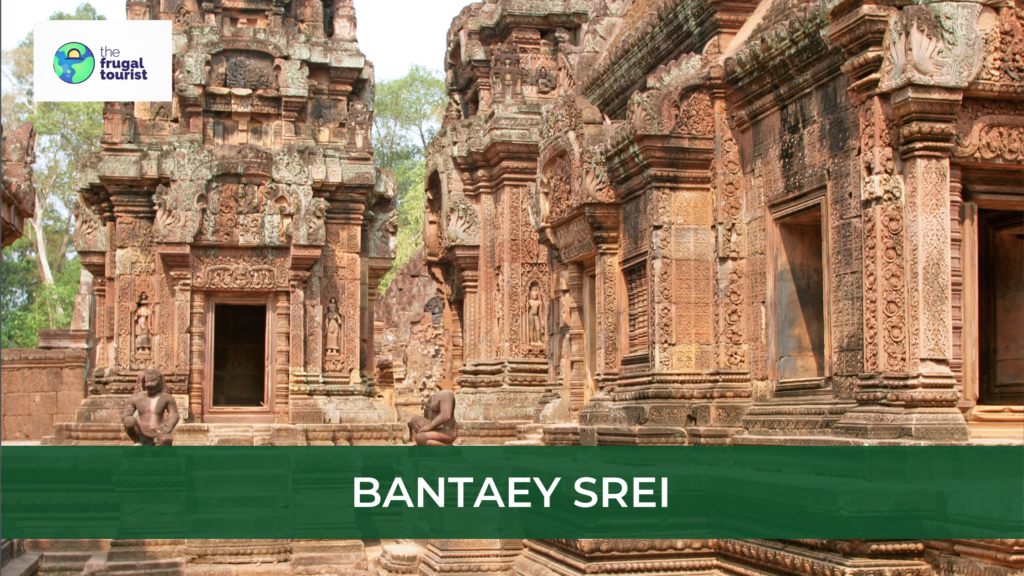
Secondary Temples
11:00 AM or after – After exploring the Banteay Srei temple, have lunch and continue with the remaining temples in Angkor Wat.
Preah Khan
Preah Khan is a sprawling temple complex with impressive corridors, towering trees, and intricate carvings.
It is a must-see due to its unique atmosphere and the opportunity to wander through its maze-like passages and discover hidden courtyards.
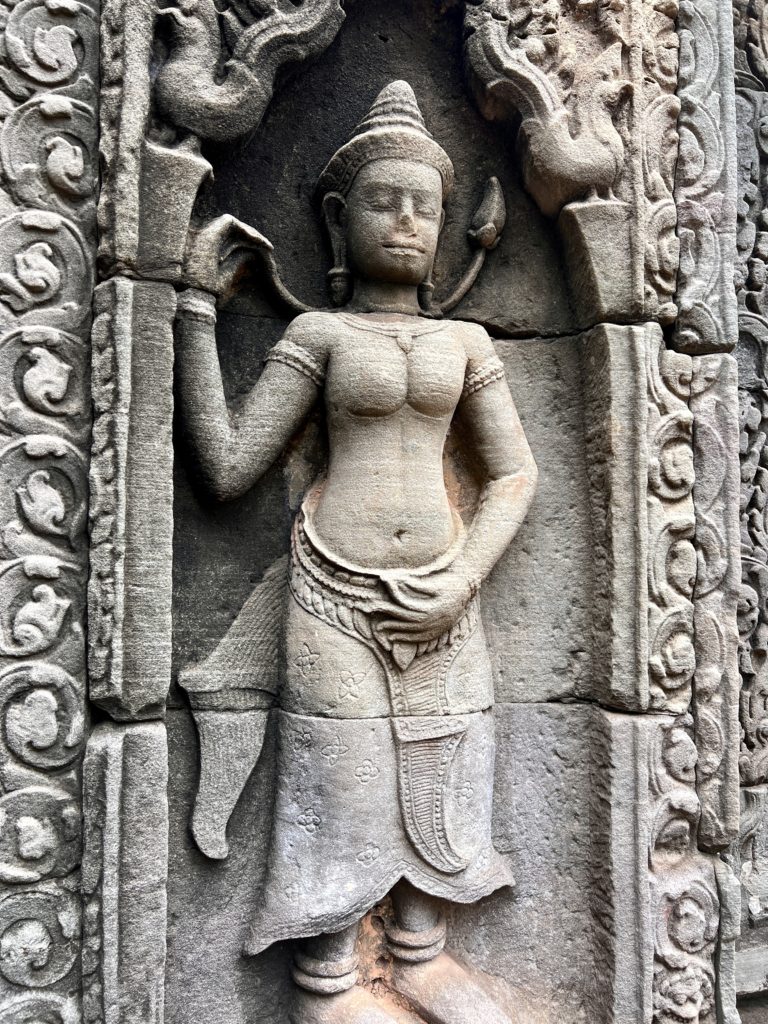
Neak Poan
Neak Poan is a small temple on an artificial island in a serene water setting.
Two mythological Naga snakes encircle its central sanctuary.
Its unique design, featuring a central tower surrounded by four interconnected pools, creates a picturesque scene, making it a must-see for its peaceful ambiance.
Ta Som
Ta Som is a smaller temple known for its stunning tree roots embracing the crumbling structures.
It offers a sense of mystery and enchantment, making it a must-see for its harmonious blend of nature and ancient architecture.
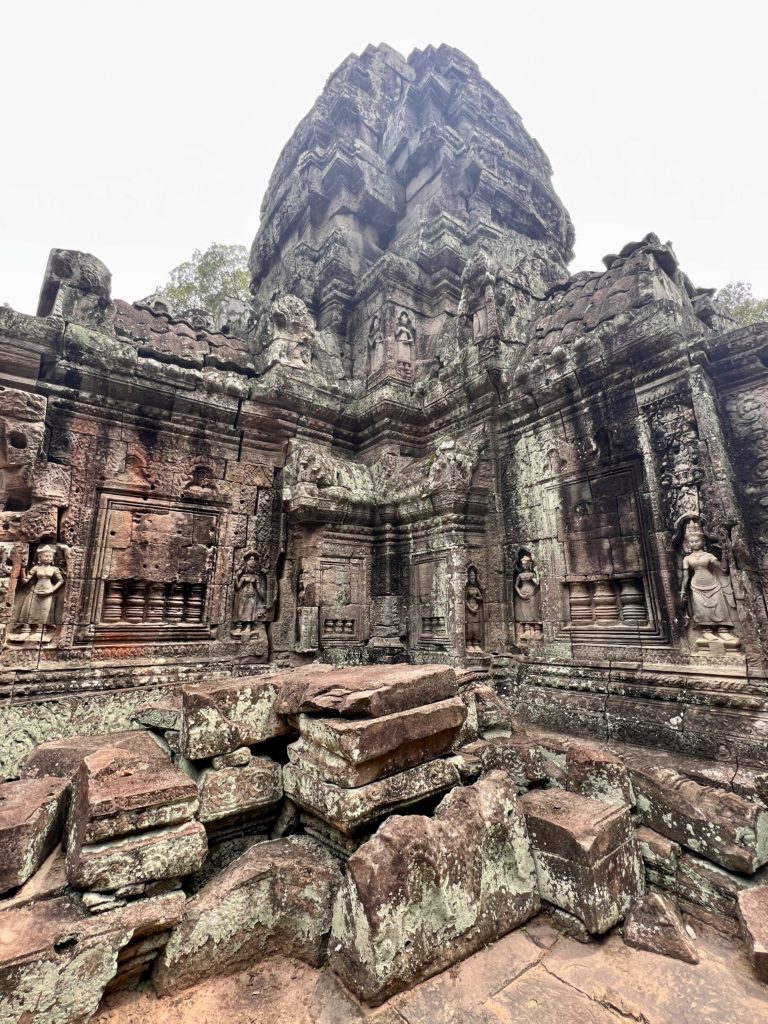
East Mebon
East Mebon is a temple mountain on a man-made island in the Eastern Baray reservoir.
It is a must-see for its impressive stone sculptures, including elephant statues, and the opportunity to enjoy panoramic views of the surrounding countryside.
Pre Roup
Pre Roup is a temple mountain with remarkable sunset views from its tall towers.
When climbing the narrow steps of this temple, it’s super important to exercise caution to keep yourself safe from falling.
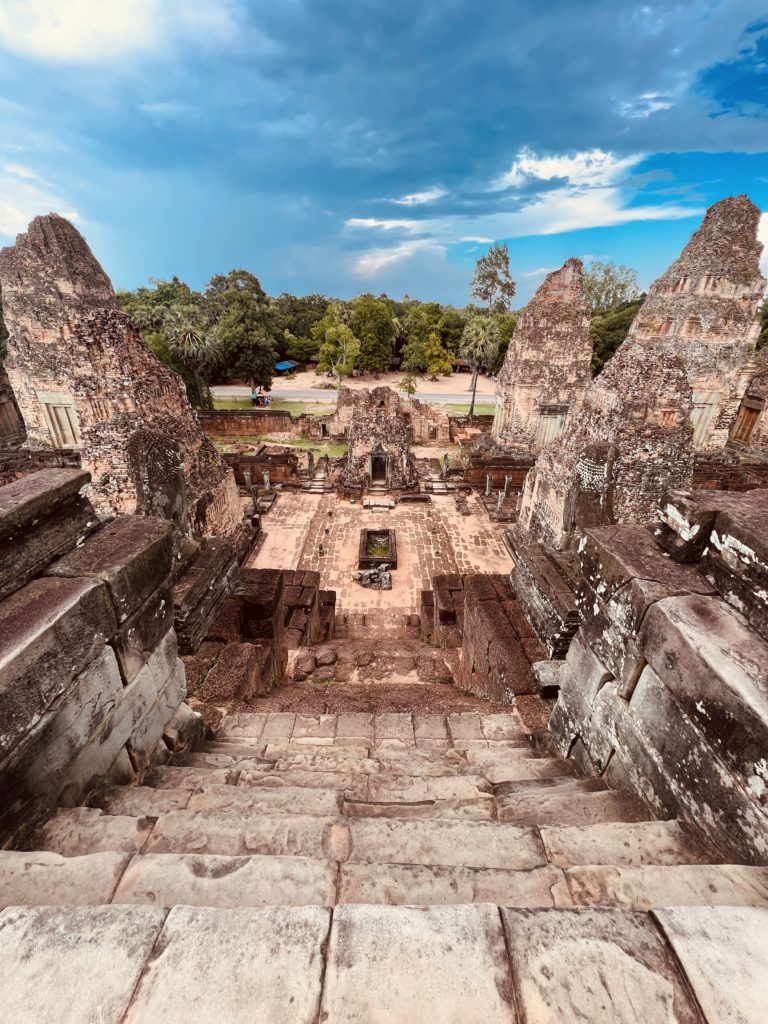
Sra Srang
This serene water reservoir provides a tranquil oasis amidst the bustling temple complex.
Sra Srang is conveniently located near other major temples, such as Banteay Kdei and Pre Roup, so it’s the perfect spot to take a break, unwind, and soak in the calming ambiance.
Banteay Kdei
Banteay Kdei is a temple complex with extensive galleries and towers featuring intricate carvings and serene courtyards.
Its peaceful and lesser-visited environment makes it a must-see for those seeking a more intimate, less-crowded temple experience.
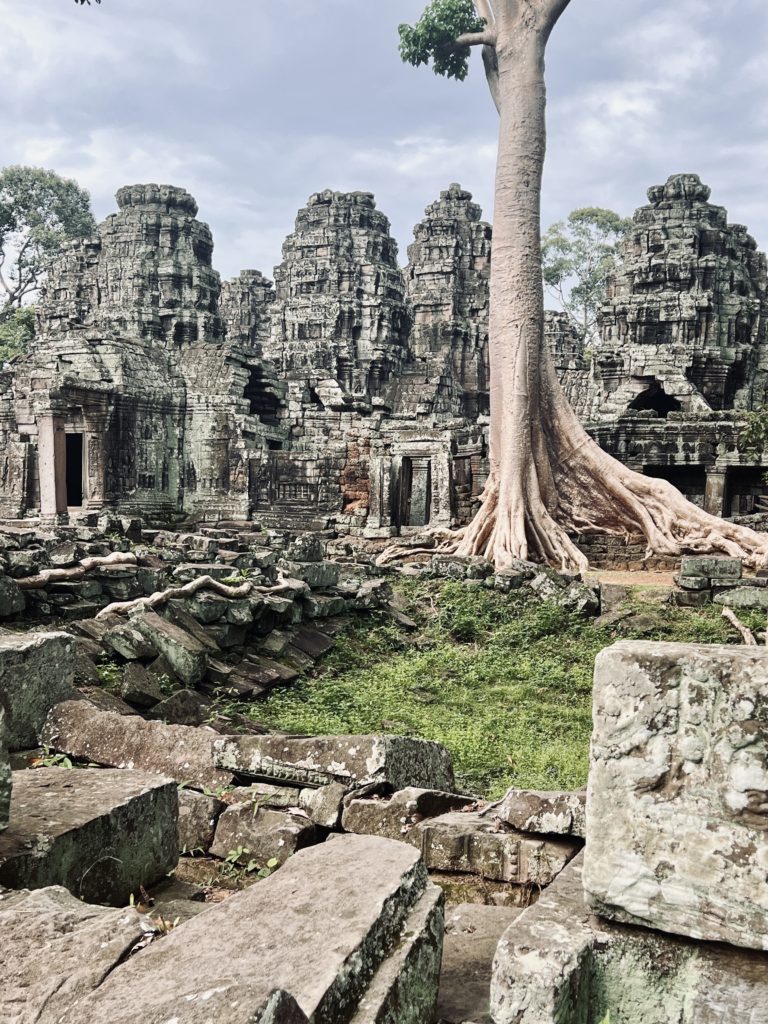
Prasat Kravan
Prasat Kravan is a group of five red brick towers with well-preserved bas-reliefs inside.
It is a must-see for its unique design and the opportunity to admire the intricate carvings depicting Vishnu and other Hindu deities.
Reminders When Visiting Angkor Wat
When visiting the temples of Angkor Wat, it’s essential to be mindful of the local culture, respect the sacredness of the sites, and ensure a positive experience for yourself and others.
Here are some important reminders for tourists:
Dress Code:
Dress modestly and respectfully when visiting the temples.
Both men and women should cover their shoulders and knees.
Wearing lightweight, breathable clothing is advisable due to the hot and humid climate.
Respectful Behavior:
Maintain a respectful and quiet demeanor while inside the temples.
Avoid loud conversations, touching or leaning on ancient structures, and be mindful of your surroundings.
Remember that these sites are places of worship for locals and are considered sacred.
No Smoking or Littering:
Smoking and littering are strictly prohibited within the temple grounds.
Help keep the environment clean by disposing of trash in designated bins.
Respect the historical and natural significance of the area by not causing any damage or pollution.
Follow Signage and Guidelines:
Pay attention to signage, instructions, and guidelines provided at the temples.
Some areas may have restricted access or specific rules to ensure the preservation of the sites.
Follow these instructions to maintain the integrity of the temples and ensure your safety.
Be Mindful of Photography:
While photography is allowed, be considerate of other visitors.
Avoid blocking walkways or creating disruptions for others.
Remember that some areas may have restricted photography or require additional permits.
Respect any signage or guidelines regarding photography.
As of my last visit, GoPros, Drones, and insta360s are not permitted.
Stay on Designated Paths:
Stick to designated paths and walkways when exploring the temples.
Veering off the paths may cause damage to delicate structures, vegetation, or archaeological remains.
Preserve the integrity of the sites by respecting boundaries and avoiding restricted areas.
Stay Hydrated:
Cambodia’s climate can be hot and humid, so staying hydrated is crucial.
Carry a reusable water bottle and drink plenty of water throughout your visit.
Utilize the water stations available at the temples for refills.
Be Prepared for Crowds:
Angkor Wat is a popular tourist destination, and certain temples can get crowded, especially during peak hours.
Be patient and respectful of other visitors. Consider visiting famous temples during off-peak hours for a more serene and enjoyable experience.
Engage Local Guides Respectfully:
If you hire a local guide, engage with them respectfully and be open to learning about the history and culture of the temples.
Support licensed guides with extensive knowledge that can enhance your understanding of the sites.
Purchase Ethical Souvenirs:
Support local artisans and buy from reputable sources when purchasing souvenirs.
Avoid purchasing items made from protected or endangered species, artifacts, or items that may contribute to looting or illegal trade.
Travel Essentials When Visiting Angkor Wat
When visiting Angkor Wat, it’s essential to pack the right travel essentials to ensure a comfortable and enjoyable experience.
Here is a list of items I recommend bringing and why they are essential:
Sunscreen: Cambodia’s climate can be hot and sunny, especially when exploring temple complexes. Protect your skin from harmful UV rays by applying sunscreen with a high SPF. Reapply throughout the day for optimal protection.
Hat: A wide-brimmed hat or a cap shields your face and head from the sun. It helps prevent sunburn and keeps you cool while exploring the temples, especially during the peak hours of sunlight.
Insect Repellent: Cambodia has mosquitos and other insects like many tropical countries. Applying insect repellent helps prevent bug bites and reduces the risk of mosquito-borne diseases. Choose a repellent with DEET or natural alternatives like citronella oil.
Towel: Carrying a small, lightweight towel is handy, especially during the hot and humid Cambodian weather. You can use it to wipe sweat, cool off, or even cover your head for extra sun protection.
Change of Clothes: Exploring the temples can be physically demanding, and you may sweat or get dirty. Having a change of clothes allows you to freshen up and feel more comfortable during your visit.
Power Bank: With the extensive use of smartphones for navigation, photography, and staying connected, it’s essential to have a reliable power source. A portable power bank ensures your devices stay charged throughout the day, enabling you to capture those memorable moments.
Sunglasses: Wear sunglasses to protect your eyes from intense sunlight and glare. Opt for a pair with UV protection to shield your eyes from harmful rays and enhance your visibility in bright conditions.
Comfortable Walking Shoes: Exploring the temple complexes involves a fair amount of walking and climbing stairs. Wear comfortable, closed-toe shoes with good support to keep your feet comfortable throughout the day. Avoid sandals or flip-flops, which may not provide adequate protection or stability.
Lightweight Backpack or Daypack: A small backpack or daypack is essential for carrying your essentials like water, sunscreen, snacks, a camera, and other personal items. Choose one with comfortable shoulder straps and compartments to keep your belongings organized.
Water Bottle: Staying hydrated is crucial in Cambodia’s hot and humid climate. Carry a reusable water bottle and refill it at the numerous water stations available at the temples. This way, you can stay refreshed while reducing plastic waste.
Where I Stayed at Siem Reap
I stayed at the fabulous Park Hyatt Siem Reap, and we redeemed 9,000 Hyatt points per night to stay at this property for free.
My Hyatt points are earned from Chase credit cards such as the Chase Sapphire Preferred® Credit Card.
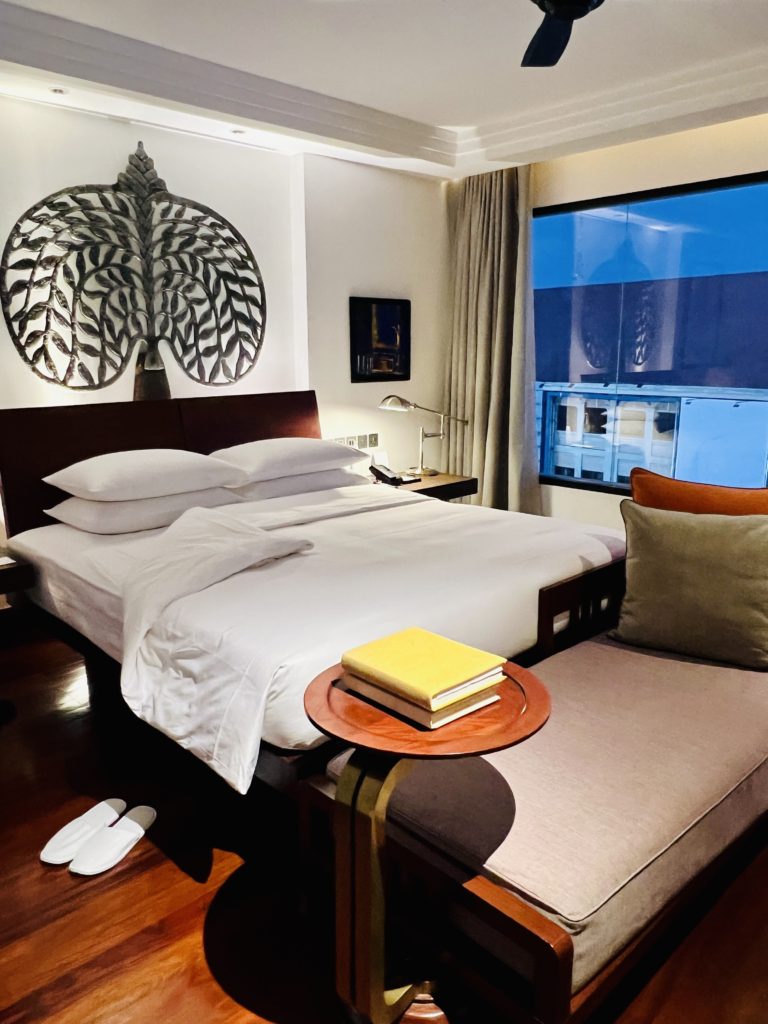
If you are new to Hyatt points, I created a free guide here.
If you are new to staying at hotels for free using points, the beginner credit card we recommend is the aforementioned Chase Sapphire Preferred.

| The Chase Sapphire Preferred® Credit Card |
|---|
| Annual Fee: $95 |
| Sign-Up Bonus (SUB): 60,000 – 80,000 Chase Ultimate Rewards Points |
| Minimum Spend Requirement (MSR): $4,000 in 3 months |
| Earn: 5X points on travel booked through the Chase Travel Portal |
| Earn: 3X points on restaurants, streaming services, and online groceries (excluding Target, Walmart, and wholesale clubs). Note this also excludes in-store grocery purchases. |
| Earn: 2X points on all other travel purchases outside of the Chase Travel Portal and 1X Ultimate Rewards points on all other spending. |
| Earn: 1 point per dollar spent on all other purchases. |
| Annual Bonus: 10% Ultimate Rewards point bonus annually based on your card spending, earned after you renew and pay your annual fee. |
| Hotel Credit: $50 hotel credit for reservations booked through the Chase travel portal each year |
| Foreign Transaction Fees: $0 |
We also have a free Travel Miles and Points Facebook Group if you would like to uplevel your travel hacking knowledge. Feel free to join!
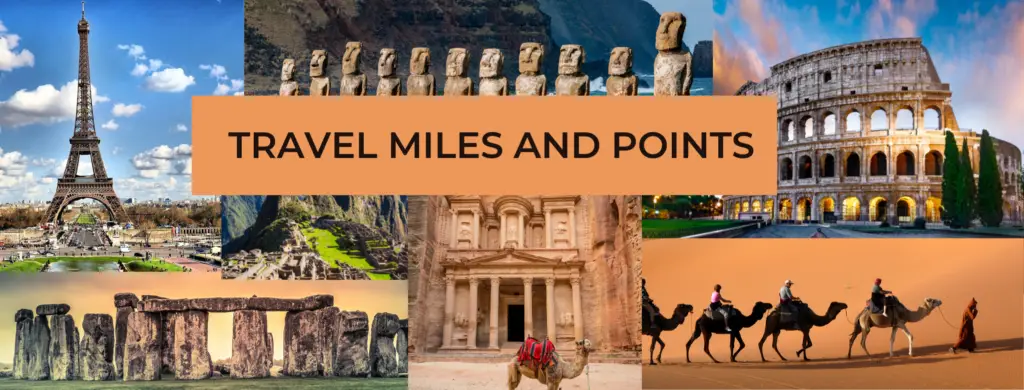
Final Thoughts
Visiting Angkor Wat is a unique and unforgettable experience.
Angkor Wat’s beauty, historical significance, and cultural immersion make it a must-see destination for any traveler.
It offers a fascinating journey back in time and an opportunity to appreciate the remarkable achievements of the Khmer Empire.
Whether you’re an architecture enthusiast, a history buff, a spiritual seeker, or simply someone who appreciates natural and cultural wonders, Angkor Wat will leave an indelible mark on your travel experiences.

